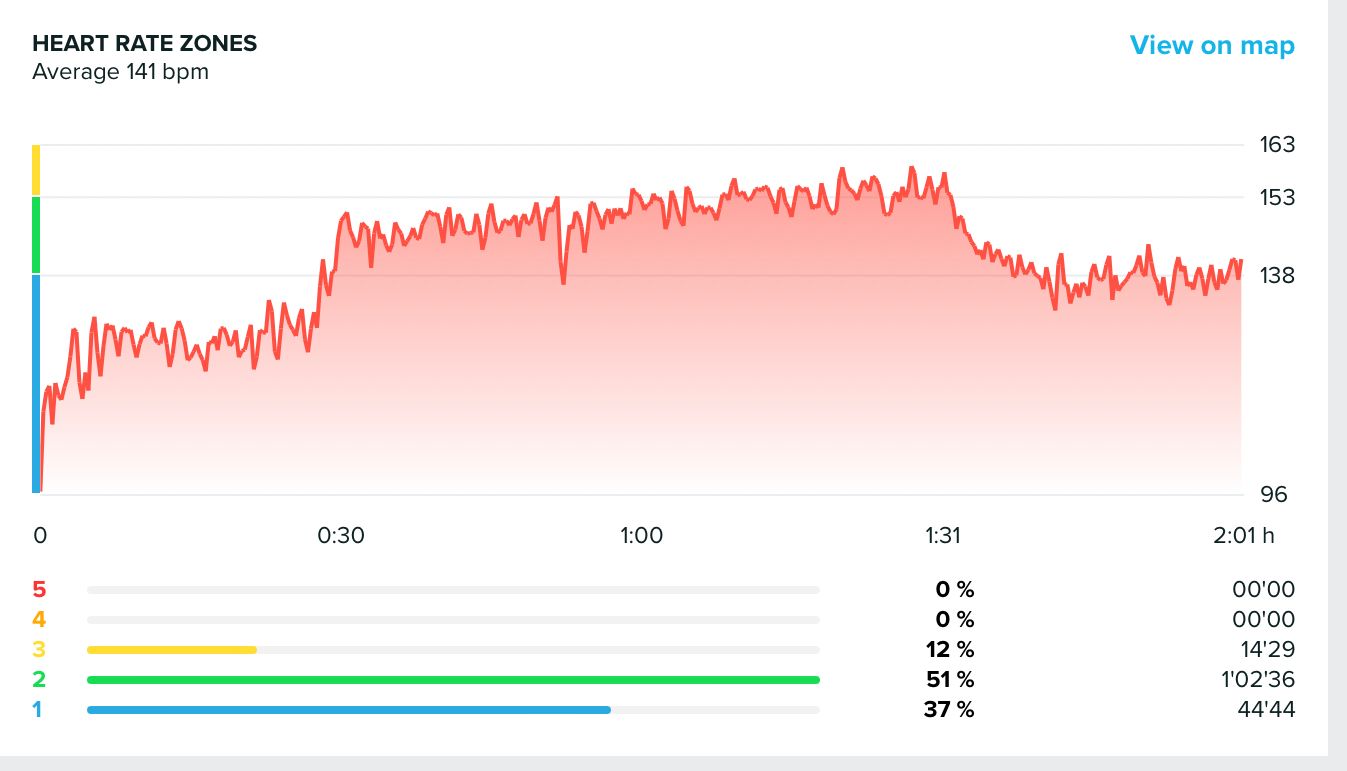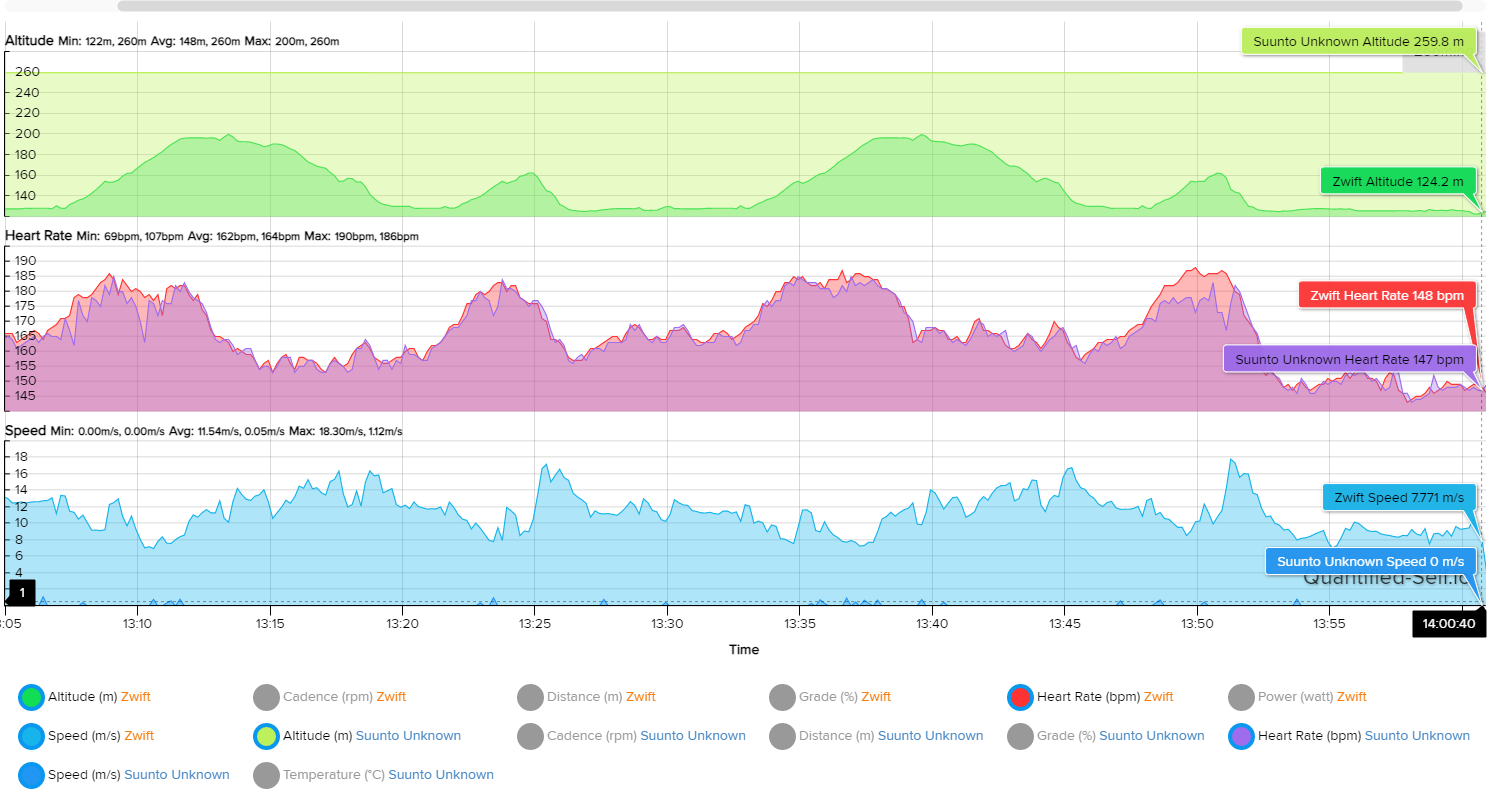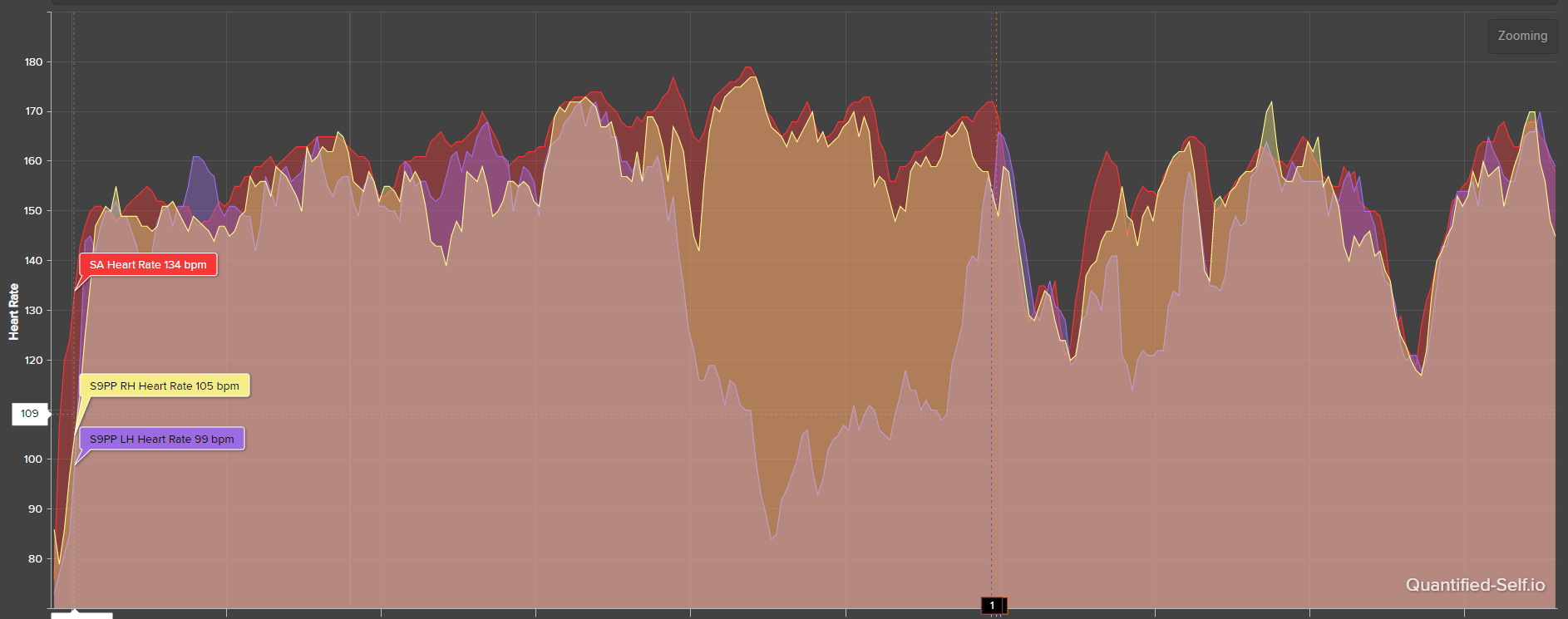HR comparison
-
@Mff73 better blood flow in left hand

-
For me, It works better than s7 s9p or s5p. They show smoother line but this is filled with details.

-
Thanks.
In this particular feature (OHR), the problem is to be sure it is working for ourself a’d then t being abl to trust it.
My last run tends to prove (once) the sensor can read my HR while running on left wrist. But for now, I have more bad readings than good ones.
I am maybe not compatible with this technology. -
For me OHR during running isn’t very accurate.
But I was quite surprised today of its accuracy during an indoor ride.
Zwift HR with Wahoo Tickr belt vs S9PP OHR.
It is often spot on except during the higher intensity efforts.
-
Just for the sake of sharing, here is a comparison with two S9PP and wrist OHR, and SmartSensor.
One S9PP on right wrist, the other on … left one Positionned as well as possible.
Positionned as well as possible.
And chest strap … with activity recorded with SA.Same heart, Same activity (trail in quite cold temperature), not same wrist… and this time left one was the worst
 and right one, not bad in average, but still some short “big” differences).
and right one, not bad in average, but still some short “big” differences).
In conclusion, i will continue definitively to use a strap as OHR is too much inconstant for me.
-
In my case, I think I’ve found my sweet spot with S9PP OHR.
For me it struggles with some cadence lock when using it on my strong hand (left) however it performs very decent on my right hand when putting it nearly 2 fingers above wrist bone, even in cold conditions (gloves 🧤 required type of weather), S9PP OHR also follows my HR better in strides peaks, something S9P didn’t,but still far from a belt.
With that said, I train by power when it comes to “quality” workouts, but I do use HR belt for those too for post analysis.
For all other easy running and long running, S9PP OHR performs just fine

-
I sometimes have such drops on belt when running in sub zero temperatures, fixed with tiny amounts of electrode gel. Ohr is fine as long as patch of skin is “readable” by sensor. Usually left wrist has no break from wearing a watch so right wrist give better results. I also noticed that s7 has about 5bpm lower sleep tracking avg hr than s9pp wrist invariant.
-
I tried ohr several times with s9pp. It’s totally unusable .
-
@zhang965 Do you have tattoos or very skinny wrists? I found for me it is very good compared to a belt. The only times it fails are in very cold weather and fast, hard intervals. Otherwise, it matches the belt. For my wife, even an Apple Watch, which is better than Garmin or Suunto in my testing does not work. She is quite thin and has very small wrists.
-
Hi, I recently purchased the new S9PP, and my HR readings are really really bad.
I know that no smartwatch is 100% accurate, but the S9PP sensor doesn’t work on my skinny wrists (no tattoos)… it is wrong by 20 to 30 bpm, even with my resting heart rate. I went for an easy run, normally when I do this I’m in the 130-145 bpm range, and half of the run my HR was above 170 (with a max HR reading of 195, when my HR max is 184), and the other half it was below 110. When resting, it shows readings of more than 60 bpm when I’m at 40-45 (checked).
Previously I had a Garmin Forerunner 245 and a Coros Pace 2, and both showed acceptable readings.
It’s a pity because I still keep my old Ambit 2S, my first GPS watch, and I really like it, and when I found the 349€ Christmas deal on Amazon for the S9PP I didn’t hesitate in buying it. I love the steps that Suunto is taking to improve the app, I love the Suunto Plus options, the build quality of the watch is great, the battery is really good as is the GPS accuracy despite not having dual band… but I’m returning the watch just due to how bad the HR sensor is.
I hope that Suunto will be able to address this issue for future watches.
-
@dmn23 said in HR comparison:
Hi, I recently purchased the new S9PP, and my HR readings are really really bad.
I know that no smartwatch is 100% accurate, but the S9PP sensor doesn’t work on my skinny wrists (no tattoos)… it is wrong by 20 to 30 bpm, even with my resting heart rate. I went for an easy run, normally when I do this I’m in the 130-145 bpm range, and half of the run my HR was above 170 (with a max HR reading of 195, when my HR max is 184), and the other half it was below 110. When resting, it shows readings of more than 60 bpm when I’m at 40-45 (checked).
Previously I had a Garmin Forerunner 245 and a Coros Pace 2, and both showed acceptable readings.
It’s a pity because I still keep my old Ambit 2S, my first GPS watch, and I really like it, and when I found the 349€ Christmas deal on Amazon for the S9PP I didn’t hesitate in buying it. I love the steps that Suunto is taking to improve the app, I love the Suunto Plus options, the build quality of the watch is great, the battery is really good as is the GPS accuracy despite not having dual band… but I’m returning the watch just due to how bad the HR sensor is.
I hope that Suunto will be able to address this issue for future watches.
yo dude, be carefully to mention other brands, this is suunto community forum, we do have fan boys here. LOL
For the OHR, I do have (almost) the same experience as you, but sadly there is no good solution.
There are my 2 points of views:
The OHR is tuned for 80% users. You and me, we are both in the 20% of suunto user, so the solution is not built for us. it’s totally normal, to tune the OHR for these 20% user could be more difficult than what they did for the 80% users.
Second one reason, suunto has some fantastic tester which are not representing the users like you or me. I saw a lot of ridiculous stories on this forum like some testers think the vo2max is not useful for them, (So you will not need it), I was totally blown away by these…people.
I’d show you my last review on S9PP OHR.
You can see what we got as replies, the OHR will work better in summer! OH GREAT, PERFECTO, how clever it is, is there anyone who only runs during summer? is there anyone who buys a watch which passed MIL-STD 810G tests only for running in summer?
-
@dmn23 I have been struggling with the OHR for months with a similar experience. I finally found that OHR is much more precise if I wear the watch really tight. It is not as comfortable as I would like, but, on the other hand, I can run without my heart belt. It is worth a try.
J
-
@zhang965 Yes, it’s a shame that the OHR doesn’t work for us. My first thought when I saw its bad performance was thinking that I had a defective unit, but after that I read so many users having the same experience… I really wish Suunto to sort this for all 100% users.
-
@Efejota I’m happy to read that you found a solution, but personally I tried so many different fits -some of them really really snug- and the HR readings did not get any better…
-
@dmn23 said in HR comparison:
@zhang965 Yes, it’s a shame that the OHR doesn’t work for us. My first thought when I saw its bad performance was thinking that I had a defective unit, but after that I read so many users having the same experience… I really wish Suunto to sort this for all 100% users.
I have one question, can I have your running activity details?
Just some numbers for example average pace/hr if you run constantly.
If you change the intensity, what is the fastest pace zone and hr?
-
@zhang965 Sure, for the easy run I mentioned above I averaged 4:45 min/km for 13k with 160 bpm (normally for this kind of run on flat terrain at that pace, I’ve been averaging around 130-140 bpm for the last few months). When I started the run, as I noticed a really high HR reading during my first 2k (above 170 bpm while maintaining a 5 min/km pace) I increased the intensity running for 400m at 3:30/km just to see if my HR values would increase even more, but they remained the same according to my S9PP (according to my own perception they were obviously much higher
 ).
). -
@dmn23 said in HR comparison:
@zhang965 Sure, for the easy run I mentioned above I averaged 4:45 min/km for 13k with 160 bpm (normally for this kind of run on flat terrain at that pace, I’ve been averaging around 130-140 bpm for the last few months). When I started the run, as I noticed a really high HR reading during my first 2k (above 170 bpm while maintaining a 5 min/km pace) I increased the intensity running for 400m at 3:30/km just to see if my HR values would increase even more, but they remained the same according to my S9PP (according to my own perception they were obviously much higher
 ).
).So, we are the same kind of runners,
I think the OHR works better with low pace and low hr.
And how about the rise to wake? It works well for you during running?
-
@zhang965 I haven’t tested the rise to wake feature, I disabled it, sorry.
-
@dmn23 said in HR comparison:
@zhang965 I haven’t tested the rise to wake feature, I disabled it, sorry.
Me too, lol,
-
@zhang965
 personally, during daytime I find the screen readability to be ok without the backlight on, and when I run at night I always wear a hedlamp… So I prefer to have the backlight disabled and that way the battery can last a little bit longer.
personally, during daytime I find the screen readability to be ok without the backlight on, and when I run at night I always wear a hedlamp… So I prefer to have the backlight disabled and that way the battery can last a little bit longer.
